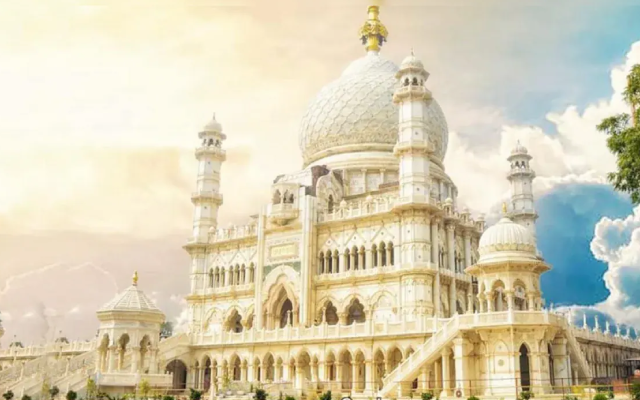A new white marble structure in Agra that took 104 years to build is daily drawing hordes of spiritually inclined tourists.

The recently constructed mausoleum of the Radhasoami sect’s founder in Soami Bagh, which is roughly 12 km from the Taj Mahal, is frequently compared by tourists to the famous Taj Mahal.
Agra’s pristine white marble structure has gained popularity as a tourist destination. The mausoleum’s majesty has left many in awe, and many see it as a strong contender for architectural grandeur alongside the Taj Mahal. The city is well-known for its Mughal-era monuments.
The Soami Bagh mausoleum was built over a century in an open society, in contrast to the Taj Mahal, which was finished in 22 years in the 17th century with the labor of thousands of skilled artisans and craftsmen under a medieval authoritarian regime.
A devoted follower of the faith, Pramod Kumar mentioned that the construction of the mausoleum was a testament to the unwavering faith, fervour, and dedication of its creators, who were driven by their religious beliefs.
Resting on a foundation of 52 wells, the 193-foot tall structure, all in white marble from Makrana in Rajasthan, is undoubtedly one of the most ambitious projects in India.
The mausoleum is dedicated to the founder of the Radha Soami faith Param Purush Pooran Dhani Swamiji Maharaj. The grand mausoleum is situated in the Soami Bagh colony in Agra’s Dayalbagh area. Each day bus loads of tourists visit the mausoleum and express their admiration and awe at the exquisite craftsmanship on display. The entrance is free while the photography is not permitted.
Some minor additions are yet to be made. One can see scores of craftsmen at the workshop equipped with huge machines using state-of-the-art technology. “Now of course we have huge grinders, cutters, finishers, lorries, lifters, and all kinds of machines and computer technology, all of which were employed to advantage here, and the results show,” an official connected with the project said.
Already visitors have begun comparing the Soami Bagh mausoleum with the world heritage monument, the Taj Mahal which draws thousands of tourists from all over the world daily. The Taj Mahal houses the mausoleum of Mughal Emperor Shah Jahan and his wife Mumtaz Mahal.
Officials who supervised the construction said, “It is a form of worship that has been going on and will go on relentlessly.”
The Soami Bagh mausoleum stands amidst a colony of the followers of the Radha Soami faith. The faith has millions of followers in states like Uttar Pradesh, Punjab, and Karnataka as well as foreign countries.
The original samadh was a simple white sandstone structure. In 1904, work began on a new design by an architect from Allahabad. Work was held up for a few years, but since 1922 to this day men have been toiling away, mostly by hand, at the enormous, highly decorated construction.
The artisans work with intense devotion. Some old men have spent all their lives on the site, as their fathers and grandfathers did before them, and as their sons and grandsons are now doing. These days the artisans have some machinery to help them, but their work is as painstaking as ever.
The architectural design of the building conforms to no particular style, modern or traditional, though in conception it is essentially oriental. An effort has been made to blend a variety of styles harmoniously.
The supporters of Soami Bagh, which is aptly named the “garden of the Lord,” vehemently refute any ambitions to challenge the Taj.
Taller than the Taj Mahal at 31.4 feet, the gold-plated pinnacle was installed using a specially designed crane that was brought in from Delhi for this extremely specialized task. The lack of available marble stones in the appropriate size meant that it took years. The majority of the marble used in the mausoleum came from Rajasthani quarries in Makrana and Jodhpur. Pakistan’s Nowshera is the source of the variegated mosaic stone. Inlay work has been made with semi-precious stones that are obtained from riverbeds in central and southern India.
The construction process faced many problems, including difficulties in procuring the right quality of marble although quarries were taken on lease in Mount Abu and Udaipur areas. To add to the woes, construction work was affected time and again due to labour shortage, as a large number of skilled masons migrated to greener pastures in Gulf countries.
While the Taj Mahal is still the top choice for tourists drawn to its romanticism and architectural magnificence, those with a more spiritual bent are choosing Soami Bagh, an architectural wonder that also serves as a hub for soul-healing and comfort.
The project’s backers argue that it is inappropriate to compare the mausoleum to any other structure, but visitors nonetheless question whether the Taj Mahal in Agra has competition.
Read More






